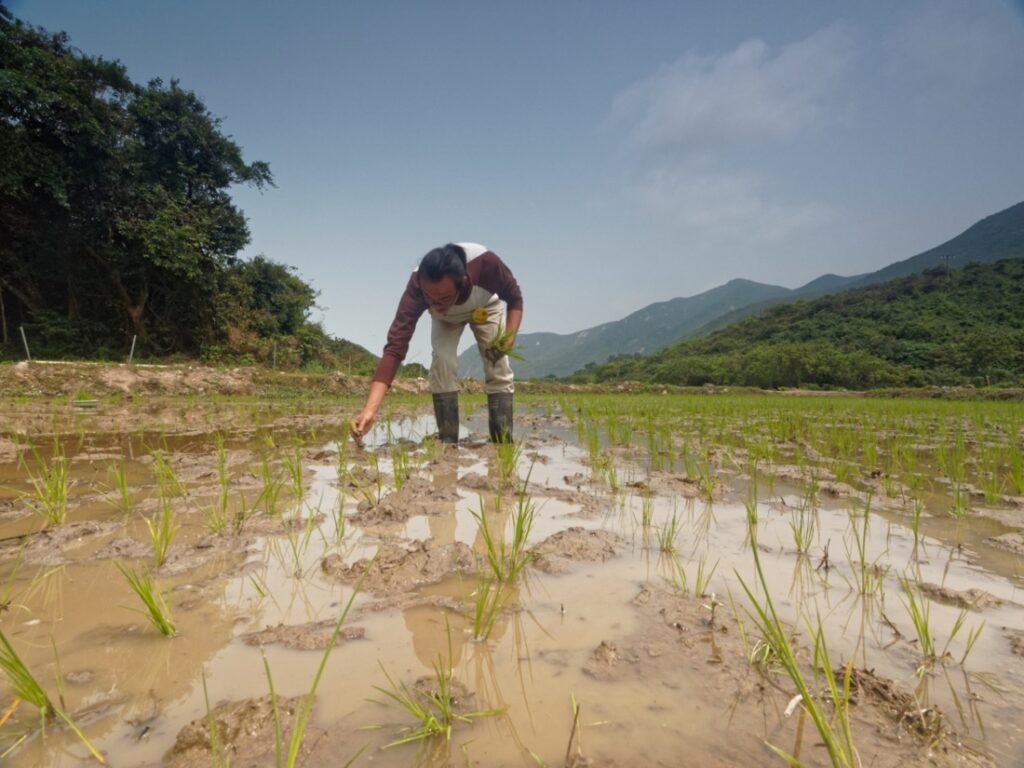Yi O, by a small bay of the same name south of Tai O on Lantau, was for some decades an abandoned area. As in much of Hong Kong’s less accessible New Territories, making a living through farming was tough, and life in towns attracted former villagers, who moved out. But now, there’s extensive farming here – and an important ecosystem may be developing. [Written in 2015]

I was among conservationists who were alarmed and even outraged as work began on clearing secondary woodland, scrubland and reedy marsh that had “gone wild”. Media reports showed fires burning amidst land scoured of vegetation. Though paid little attention by naturalists, Yi O was known to hold species such as Romer’s tree frog, which is unique to Hong Kong: these would be threatened by the habitat destruction.
During a visit in April 2013, I walked through the area, finding extensive cleared land but only tiny farming – notably a couple of rice fields maybe the size of a couple of badminton courts. Surely this was “fake farming” of the “destroy first, build later” kind?
Adding to the negative impression, there were signs warning that anyone visiting would be “treated as a thief” – which followed rambunctious former villagers blocking the Lantau Trail through Yi O some years ago. Plus, I learned of an agreement to build a resort within a couple of decades.
And yet… I’ve visited more recently, from February last year onwards, and seen far more of the area is being farmed. I’ve talked with two key managers of the farming project, who have assured me that they aim to make farming – especially of organic rice – a success. There might still be some people hoping for concrete style developments, but in my view there is also hope that Yi O could become important for farmland that supports notable wildlife species, along with supporting Hong Kong style nature tourism.
Rice is targeted as the key crop, grown in paddies created low on the gentle slopes of the valley leading down to Yi O “new village”. I think Yi O now has the most extensive rice paddies in Hong Kong, though admittedly competition is not strong, and the area is tiny compared to Hong Kong of earlier last century. There are also smaller fields with vegetables, herbs, and a very few ornamental plants.
While trees were felled during land clearing, there is still some fung shui woodland around the “new village” near the coast, where mangroves grow on the muddy shoreline and in the mouth of the creek. A historic boulder trail – along which the Lantau Trail passed, and you can still hike, runs through woodland, before the route crosses fields below the “old village”, and re-enters woodland higher in the valley.
There’s more woodland on the slopes, along with scrubland, rough grassland, and a marshy area along the creek with tall, dense reeds.
So there’s a mix of habitats at Yi O, including some such as paddies that have become very rare in Hong Kong, leading to steep declines in species they supported.
Though some members of the project team watch for wildlife, there haven’t been intensive observations that I’m aware of (you can see some photos of butterflies, birds, reptiles etc on the Yi O Agricultural Cooperation website, at: http://www.yio.com.hk/biodiversity).

During recent visits (including after 2015), I’ve looked for birds, especially, and found a fair variety though nothing outstanding. These have included two Yellow-breasted Buntings – now a scarce species in Hong Kong, but disappointing to me given there had been around 100 at Long Valley a few days before! Also Chestnut-eared Bunting, also scarce in Hong Kong, along with Common Kestrel, Red-billed Starling and Black-naped Monarch. Plus, butterflies have been relatively common, and more diverse than I notice in many places.
So there’s scope for finding notable wildlife; you might enjoy a visit (by contrast to the signs mentioning “thieves”, members of the project team evidently welcome visitors). Indeed, given observations showing southwest Lantau is among the best places in Hong Kong for finding migratory birds, Yi O could be a birding “hotspot”.
There’s also potential for habitat improvements. I’ve suggested a few ideas to the project managers – like creating pools with open water in the marshy area, along with planting trees with flowers and fruits that attract birds and other wildlife, as well as being appreciated by people. A short path by a tiny stream looks ready made for a mini nature trail.
The project is a cooperative venture, with plans to generate income that can be shared with former villagers. Produce is sold in a small shop in Tai O, as well as through the website. But more money will surely be needed than rice and vegetables can generate. Small scale tourism, with Hongkongers the main visitors, seems one option for bringing revenue.
There are plans for a campsite, ideas for a restaurant. If these can be realised, I believe Yi O can become popular with hikers and naturalists. If so, maybe this can in turn build support for restricting “development” here to organic farming and nature tourism, whilst resisting grandiose ideas for a resort and, importantly, trying to reject notions for building a road south from Tai O.
Well, the above is based on visits and discussions that have led to my views regarding the Yi O project changing from anger to affinity for the team’s aims. I believe it’s worth supporting the farming venture. I hope you will visit, and judge for yourself, maybe support if it seems worthwhile.
